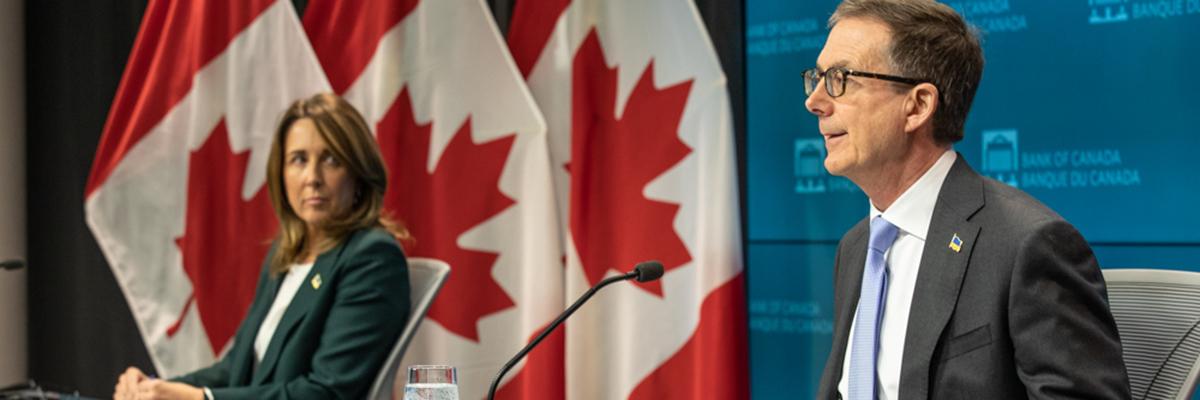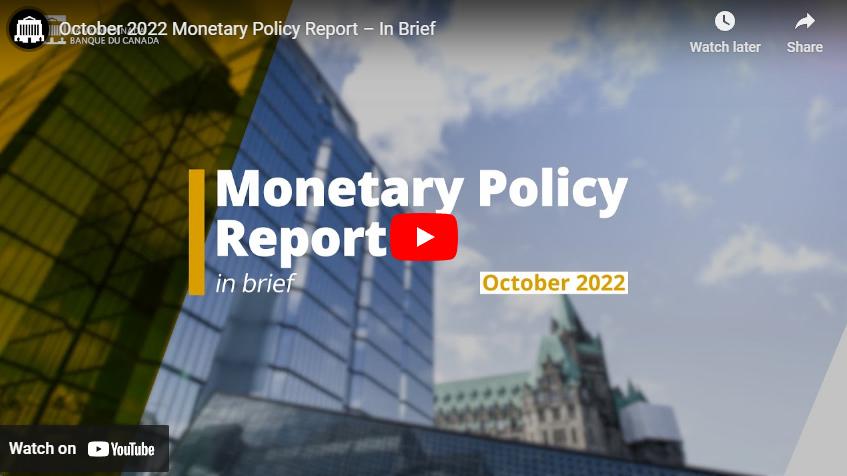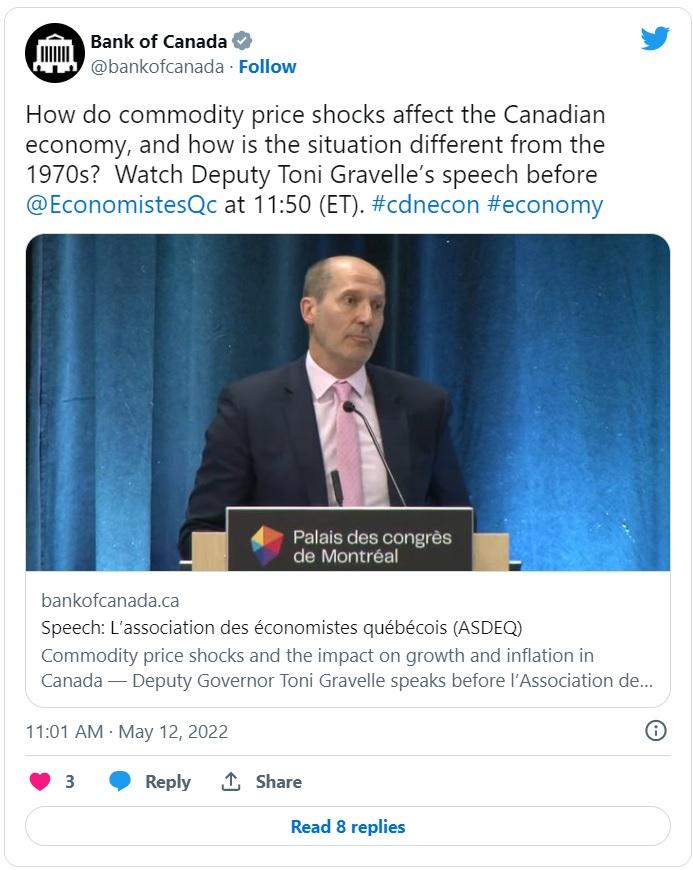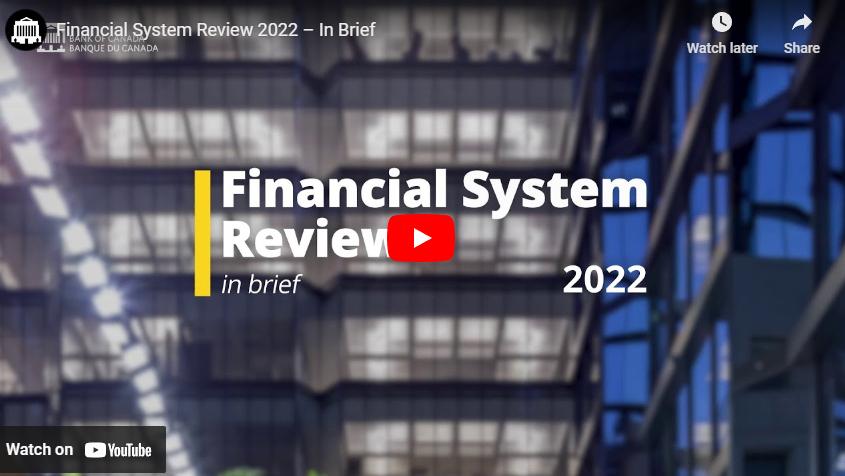Annual Report 2022

Governor’s foreword
Last year was tough for Canadians and challenging for the Bank of Canada.
Inflation started the year at just under 5% and rose to 8% in June, before falling to just over 6% by the end of the year. Canadians experienced the hardship of high inflation, finding it increasingly difficult to stretch their paycheques and cover their bills. Lower-income Canadians were especially hard hit because the prices of many essentials—such as food and rent—rose sharply.
Understandably, Canadians had many questions for the Bank of Canada. Why is inflation so high? What is the Bank doing about it? And when will inflation come down? Let me address each of these in turn.
At the start of 2022, inflation was already elevated. This largely reflected widespread and persistent supply chain disruptions amid strong global demand for goods. Then in February, Russia’s unprovoked invasion of Ukraine caused global prices of oil and other commodities to rise sharply, pushing inflation even higher. And from there, inflation broadened and intensified. This reflected the pass-through of higher energy, food and shipping costs to many goods and services prices. It also reflected rising price pressures domestically. When the Canadian economy fully reopened, consumers wanted to catch up on what they had missed, but businesses couldn’t keep up with the increased demand. This put upward pressure on the prices of many services.
The Bank was—and remains—resolute in its commitment to return inflation to the 2% target. To bring inflation back down, we raised the policy interest rate through seven consecutive monetary policy decisions in 2022, taking it from a COVID‑19 pandemic–related low of 0.25% all the way to 4.25%. In April, we also began quantitative tightening, the process of shrinking the Bank’s balance sheet.
Because inflation rose quickly, we moved interest rates up forcefully. History tells us this approach gives us the best chance of avoiding the need for even larger increases later and, potentially, a severe recession—something no one wants.
By the end of 2022, inflation was still too high, but it had started to decline. This mainly reflected lower energy prices and the easing of global supply chain bottlenecks. More restrictive monetary policy had also started to reduce spending, especially in parts of the economy that are sensitive to interest rates, such as housing and furniture sales.
As we move through 2023, we anticipate the effects of higher interest rates will continue to spread through the economy, slowing spending further and letting supply catch up to demand. This should relieve price pressures more broadly and bring inflation down substantially over the course of the year.
The large climb in inflation through the first half of 2022 surprised us. The misses in our forecasts led to an intensification of work to better understand inflationary pressures and the appropriate responses to them during times of global upheaval and supply constraints. Three lessons stand out:
- Increasing the supply of goods and services is harder than restoring demand. Our monetary policy tools were very effective in supporting demand through the pandemic, but we underestimated the persistence of supply disruptions.
- The overall gap between demand and supply in the economy doesn’t tell the whole story. During lockdowns, higher demand for goods did more to push prices up than lower demand for services did to pull them down.
- The inflationary consequences of supply disruptions are more acute when the economy is overheated. That’s because businesses aren’t as worried that they will lose sales if they raise prices.
We know that the adjustment to higher interest rates has been hard for many households—particularly those with significant debt loads. And we also know that, for many, it can be counterintuitive that raising borrowing costs when other costs are already rising will reduce inflation. But by the end of 2022, we could see tighter monetary policy beginning to help rebalance the economy and reduce inflationary pressures. We ended the year a long way from our 2% inflation target, but we are confident that monetary policy is working to restore price stability.
Also in 2022, the Bank incurred a net loss for the first time. Following a period of above-average income associated with quantitative easing in 2020 and 2021, the Bank incurred a net interest expense in 2022. We expect to continue to incur such losses for a couple of years before returning to a positive net income position. The size and duration of the losses will depend on a number of factors, including the path of interest rates and the evolution of both the economy and our balance sheet.
The Minister of Finance has indicated that the government plans to introduce legislative amendments to allow the Bank to temporarily retain its net income in the future instead of remitting it to the Government of Canada. This would give the Bank the ability to offset net losses with future net income. Once sufficient positive equity is restored, the Bank would resume remitting to the government. I want to stress that we do not conduct monetary policy with a profit motive. Our policy decisions are driven by our price and financial stability mandates.
Throughout 2022, we maintained our commitment to transparency and promoted public understanding through proactive communications, outreach and engagement. We welcomed tough questions, and we were transparent about what we got right and what we didn’t. We explained our decisions and thinking in press conferences, speeches and media interviews. We also stepped up our efforts to engage with Canadians through effective use of social media and the reopening of the Bank of Canada Museum.
Beyond the immediate challenges of the pandemic and high inflation, we continued our focus on operational resilience and completing major business transformations—such as reinforcing our ability to recover from disruptions and enhancing our cyber security controls.
We also expanded our tool kit for understanding economic and financial system risks associated with climate change. We published results of a pilot project—undertaken with the Office of the Superintendent of Financial Institutions and several major financial institutions—to assess how the economy and financial system may be affected by different transition scenarios to a lower-carbon economy.
We enhanced our global influence in several critical areas. These include the evaluation of the Basel III banking reforms, the future of the international monetary system, and the development of global best practices for regulating crypto assets.
Here in Canada, we promoted the stability and security of a rapidly evolving landscape for payment systems and methods.
- We continued our work related to the new mandate that we took on in 2021 for retail payments supervision in Canada.
- We expanded our engagement with industry to fully understand the breadth and interconnectedness of the retail payments ecosystem.
- We also provided advice to the Department of Finance Canada as it developed regulations.
Throughout the year, the Bank focused on supporting our employees in their return to onsite work after more than two years away from the office. We launched a hybrid work model and made sure our physical and online spaces were ready.
Our leaders and staff continued to display integrity, professionalism and a tireless work ethic. They were supported in their work by an updated strategy to support equity, diversity and inclusion, and we created an accessibility plan in collaboration with stakeholders from across the Bank. So I am delighted that we were named one of Canada’s Top 100 Employers for the 13th consecutive year as well as one of Canada’s Top Family-Friendly Employers and Best Diversity Employers.
As for our top job—controlling inflation—Canadians can count on us to get it done. High inflation has been painful for everyone, but our forceful response in 2022 is working. Demand is slowing, allowing supply to catch up, and inflation is coming down. We are determined to restore price stability so that Canadians can once again enjoy low, stable and predictable inflation and sustainable economic growth.
On behalf of the Bank’s Board of Directors and staff, I pledge the Bank’s continued service to Canadians as we face new challenges in the year ahead. No matter what 2023 brings, we will continue to promote the economic and financial well-being of Canadians from coast to coast to coast.
Tiff Macklem
Governor

2022 by the numbers
6.8%
Consumer price index inflation
4.25%
Policy interest rate at year-end
$119.7
billion—Value of bank notes in circulation as at December 31, 2022 (up from $115.2 billion at the end of 2021)
3.6%
Canada’s real gross domestic product growth as estimated at December 31, 2022
5%
Canada’s unemployment rate as at December 31, 2022
73.83
US cents—Exchange rate for Can$1 as at December 31, 2022
$199.5
billion—Nominal value of marketable bonds issued by the Government of Canada in 2022
$56.0
billion—Reduction in the nominal value of Government of Canada bonds held by the Bank of Canada
100%
Percentage of Bank operations powered by renewable electricity
2,250
Number of employees as at Dec 31, 2022
One of the best places to work in Canada
13
Consecutive years as one of Canada’s Top 100 Employers
6
Consecutive years as one of Canada’s Top Family-Friendly Employers
4
Consecutive years as one of Canada’s Best Diversity Employers
13
Consecutive years as one of the National Capital Region’s Top Employers

Mandate and planning framework
Mandate
The Bank of Canada is the nation’s central bank. Its mandate, as defined in the Bank of Canada Act, is “to promote the economic and financial welfare of Canada.” Its vision is to be a leading central bank—dynamic, engaged and trusted—committed to a better Canada.
The Bank has five core functions:
- Monetary policy—to keep inflation low, stable and predictable
- Financial system—to promote safe, sound and efficient financial systems within Canada and internationally
- Currency—to design, issue and distribute Canada’s bank notes
- Funds management—to act as fiscal agent for the Government of Canada, advising on and implementing its public debt and foreign exchange reserve strategies
- Retail payments supervision—to supervise payment service providers in order to build confidence in the safety and reliability of their services and to protect users from specific risks
Efficient, cost-effective and innovative operations help the Bank achieve its mandate and business objectives.
Planning framework
A robust planning framework puts the Bank’s vision and mandate into practice. Every three years, the Bank develops a strategic plan to establish its goals, priorities and measures of success.
The strategic plan:
- helps the Bank anticipate and adapt to the realities of its operating environment
- guides annual planning and budgeting activities
- serves as the foundation for departmental and employee performance agreements
In 2022, the Bank completed the first year of its 2022–24 strategic plan, Delivering on Our Promise. The plan and its five overarching themes provide a framework to guide decision making while leaving room for the flexibility and agility needed in a changing environment.
Reporting
The Bank is committed to:
- publishing information about its operations
- reporting on its financial and non-financial performance during the year
On this page

Monetary policy
Growth was robust in the first half of 2022 as the Canadian economy reopened. High commodity prices and the easing of public health restrictions boosted economic activity.
At the same time, a tight labour market and global supply chain challenges restrained the ability of supply to meet strong demand from households and businesses. High global energy and food prices, in addition to excess demand, contributed to a rise in inflation that peaked in June at 8.1%.
In this context, the Bank of Canada raised its policy rate seven times in 2022, for a total increase of 400 basis points. It also undertook quantitative tightening. By year-end, the Canadian economy had slowed significantly, and inflation had fallen to 6.3%.
Consumer price index inflation reaching a 40-year high
Throughout 2022, the rise in inflation in Canada and abroad was pronounced. This was partly due to global developments—the war in Ukraine, strong global demand for traded goods and continued supply chain disruptions boosted inflation around the world. But what started as inflation driven by higher global energy and goods prices became generalized inflation as domestic prices also began moving up quickly. As the Canadian economy reopened, not enough goods and services were available to meet strong demand, and businesses raised prices.
In the second half of the year, inflation started to decline, mostly due to falling gasoline prices, but by year-end it was still well above the Bank’s target.
Near-term inflation expectations in Canada rose through 2022, as they did in many other economies. The Bank’s survey results indicated that consumers and businesses became more uncertain about future inflation and more of them expected it to be higher for longer.1 However, longer-term inflation expectations remained reasonably well anchored.
Taking action on high inflation
The COVID-19 pandemic has had serious implications for the economy and the financial system. The Bank, like many of its central bank peers, took extraordinary action to restore the functioning of financial markets, mitigate severe economic fallout and support the economic recovery.
Most recently, central banks have been increasing policy rates to address high inflation. The Bank began to raise its policy rate in March 2022 and was among the most forceful in using higher interest rates to cool inflation. The Bank was also among the first to begin quantitative tightening, which it did in April by ceasing to replace its maturing bond investments. Quantitative tightening complements the rise in the policy interest rate by putting upward pressure on long-term interest rates and making borrowing more expensive.
To reinforce the target rate, the Bank modified the structure and terms of its financial market operations. The Bank also announced that it will continue to implement monetary policy through a floor system—as opposed to a corridor system—where the interest rate on the overnight deposit facility is equal to the target for the overnight rate.2
With the increases in the policy interest rate, the Bank, like many other central banks that used their balance sheet to help lower interest rates, is now facing net losses—$1.11 billion in 2022. The losses are occurring because the interest the Bank receives on the assets it bought remains fixed, but the interest it pays on settlement balances used to finance the asset purchases has increased along with the policy rate.
The size and duration of these losses will depend on the path of interest rates and the evolution of both the economy and the balance sheet. The losses have no impact on monetary policy or the Bank’s operations. Policy decisions are guided by the Bank’s price and financial stability mandates.
Slower growth and easing inflation pressures in the second half of 2022
Tighter monetary policy helped start to rebalance supply and demand in the economy. In the second half of the year, economic activity started showing signs of moderation, including softening demand in sectors sensitive to interest rates.
- The housing market was the first sector to slow in response to tighter financial conditions.
- Increases in interest rates also dampened consumption growth.
Overall, economic growth was at 0.0% by the fourth quarter.
In addition to signs that demand was slowing, supply was also improving.
- While supply chain bottlenecks remained an issue throughout 2022, trade data and business survey results suggest improvement in the second half of the year.
- Labour markets remained tight, but labour shortages faced by businesses eased slightly toward the end of the year.3
In this context, three-month rates of total consumer price index (CPI) inflation and core inflation receded, indicating that CPI inflation would likely continue to moderate in the coming months.
We are seeing early signs that balance between supply and demand has started to be restored. Read Deputy Governor Sharon Kozicki’s speech before @iduquebec to learn more: http://ow.ly/OePi50LYL6b #cdnecon Dec 8, 2022
Supporting the Bank’s monetary policy function
Despite the highly complex forces affecting total supply and demand, the Bank correctly anticipated that growth in gross domestic product in Canada and abroad would be robust in the first half of 2022 before moderating in the second half of the year. However, the extent of the continued rise in inflation was much greater than expected.
| Achievement of target for consumer price index (CPI) inflation | |||||||
| Key indicators | Reference level | 2017 | 2018 | 2019 | 2020 | 2021 | 2022 |
| CPI inflation (%) | 2.0 | 1.6 | 2.3 | 1.9 | 0.7 | 3.4 | 6.8 |
| Average CPI inflation since 2001 (%) | 2.1 | ||||||
| Inflation expectations at a 10-year horizon (%) | 2.0 | 2.0 | 2.0 | 2.0 | 2.0 | 2.0 | 2.0 |
Working to better understand inflationary pressures and expectations
The appendix to the July 2022 Monetary Policy Report describes why the Bank missed predicting the rise in inflation and its persistence:
- Global factors appear to explain about two-thirds of the inflation miss. In particular, commodity prices were unexpectedly high following the Russian invasion of Ukraine. Increased supply shortages and rising shipping costs also contributed to stronger inflation.
- The faster-than-expected recovery in the Canadian economy added to the Bank’s inflation forecast errors.
Staff conducted extensive analysis on inflation expectations:
- The Bank’s consumer and business surveys provided key information on the evolution of Canadians’ expectations.
- Staff considered different paths for how expectations might evolve and assessed the implications for the inflation forecast.
This work also allowed the Bank to analyze various macroeconomic scenarios in which long-term inflation expectations become de-anchored as well as their implications for monetary policy.
How do commodity price shocks affect the Canadian economy, and how is the situation different from the 1970s? Watch Deputy Toni Gravelle’s speech before @EconomistesQc at 11:50 (ET). #cdnecon #economy https://t.co/KunhnODmyC
— Bank of Canada (@bankofcanada) May 12, 2022
Integrating a variety of data points to strengthen analysis
Reflecting the high level of economic uncertainty, the Bank sought out new data to augment its analysis.
- It developed a new survey, the Business Leaders’ Pulse, which allows the Bank to reach a more diverse set of firms than before.
- The Market Participants Survey collects information from market participants on their expectations about key macroeconomic variables and monetary policy. This survey feeds into the Bank’s financial market analysis and supports policy decisions.
- Innovative use of disaggregated data helps to deepen the Bank’s understanding of several issues—for instance, the uneven effects of monetary policy on households and on businesses.
The Bank continued to integrate climate considerations into its assessment of the economy. This included reviewing macroeconomic modelling of approaches to the transition to low carbon and beginning to modify the Bank’s large-scale models to better capture the economic impacts of the transition to net-zero emissions.
The Bank is committed to advancing economic inclusion and opportunity for Indigenous Peoples. In 2022, it began to lay the groundwork with Indigenous groups across Canada to develop an economic reconciliation action plan.4 Bank staff also examined how monetary policy is transmitted to Indigenous economies. Such analysis gives the Bank a clearer picture of the different ways its actions affect various groups.
Looking forward
In 2023, the Bank will continue to assess the effects of higher interest rates on inflation and the broader economy. In addition, the Bank will:
- continue to identify and quantify the factors that drive inflation, including the roles of domestic supply and global factors
- improve its macroeconomic models to help shed light on inflation pressures, including through richer modelling of production networks, input-output linkages and wage- and price-setting behaviours
- extend work on what digitalization, automation and the adoption of advanced technologies mean for the Canadian economy
- initiate a review to determine the appropriate steady-state level of settlement balances and support the implementation of monetary policy and long-term management of the Bank’s balance sheet
- enhance its surveys of businesses and consumers to better understand the changing economy and begin publishing the results of its Market Participants Survey roughly two weeks after the publication of each Monetary Policy Report, starting in February 2023
- 1. Bank of Canada, Canadian Survey of Consumer Expectations and Business Outlook Survey.[←]
- 2. Bank of Canada, “Bank of Canada announces changes to its operations to reinforce its target for the overnight rate” (market notice, March 2, 2022).[←]
- 3. Bank of Canada, “Labour market recovery from COVID‑19.”[←]
- 4. L. Schembri, “Economic reconciliation: Supporting a return to Indigenous prosperity” (speech to the National Aboriginal Capital Corporations Association, Gatineau, Quebec, May 5, 2022).[←]
On this page

Financial system
The Canadian financial system has remained resilient throughout the COVID‑19 pandemic. This partly reflects the fact that banks relied on sound underwriting practices before the global health crisis and had strong capital and liquidity buffers going into it. Extraordinary policy support during the pandemic, including from the Bank of Canada, was also a key factor.
However, in 2022, financial system vulnerabilities became more complex and risks increased. This is because of new challenges facing the global and Canadian economies, including high inflation, rapidly rising interest rates and slowing growth. Russia’s invasion of Ukraine added to these challenges, intensifying financial market volatility and increasing risks associated with cyber security and the transition to a low-carbon, net-zero economy.
Monitoring vulnerabilities and risks
The Bank’s 2022 Financial System Review presented assessments of key vulnerabilities to the financial system; more detailed analysis is available on the Financial System Hub.
Elevated levels of household debt and high house prices remained two key interconnected vulnerabilities. Throughout the year, Bank staff used microdata to better understand and explain their evolution, notably by:
- assessing the impact of higher interest rates on mortgage payments
- examining mortgage activity by real estate investors
- analyzing the surge in house prices in Canada’s major cities and their suburbs
- publishing a new set of indicators related to these two financial vulnerabilities
Climate change remained an important area of focus for the Bank in 2022 because increases in the frequency and severity of extreme weather events and the transition to a low-carbon net-zero economy pose significant risks to the financial system. The Bank published a report that helped deepen its understanding in this area. This project was an important first step toward gaining a better understanding of the potential exposure of the financial sector to climate transition risks.
The Bank remains actively involved in studying cryptoasset markets and their implications for financial stability. In 2022, Bank researchers published the results of a survey to assess the knowledge and ownership of Bitcoin by Canadians. Also, Bank staff analyzed the benefits and potential risks associated with cryptoassets backed by national currencies, known as stablecoins.
ICYMI: More Canadians are investing in cryptocurrencies, but the growth of these markets has outpaced global efforts to regulate them. They are also vulnerable to large and sudden price declines. http://ow.ly/LQix50JuNVnJun 10, 2022
Analyzing the link between monetary policy and financial stability
Bank researchers explored how unconventional monetary policy interacts with financial stability. Staff analyzed how expansions and contractions in the Bank’s balance sheet impact the banking system. They also developed a model to understand how asset purchases by a central bank can ease pressures on investment dealers during a liquidity crisis.
Monetary policy models with linkages to financial stability provided insight into how raising interest rates could generate financial stress for some borrowers and possibly lead to a further slowing of the economy. Also, staff analyzed how elevated house prices and the decision to buy a house could interact with slowing growth in gross domestic product, especially when homebuyers expect house prices to continue rising.
The Bank paid close attention to how the pandemic affects households differently.5 Notable research analyzed how such diverse experiences could interact with existing financial vulnerabilities, like elevated indebtedness.6 Finally, researchers studied how the range of household financial experiences—particularly regarding the use of mortgage credit—could affect the transmission of monetary policy throughout the economy.
Promoting financial system resilience
Throughout 2022, the Bank worked closely with federal and provincial authorities to monitor, exchange knowledge and promote the resilience of Canada’s financial system.
This included ongoing work with the Heads of Regulatory Agencies and Systemic Risk Surveillance committees.7 Through these federal-provincial forums, the Bank helped improve information sharing and stimulate debate on important financial system issues, including:
- vulnerabilities associated with household indebtedness and the housing market, including the role of investors
- market liquidity issues in fixed-income markets, including open-ended funds8
- risks and gaps in the regulatory perimeter associated with fiat-referenced cryptoassets
- operational risks and the cyber resilience of the financial system
Russia’s invasion of Ukraine increased risks to the cyber security of the financial sector. The Bank and its partners reinforced their cooperation and collaboration on these issues, primarily through the Canadian Financial Sector Resiliency Group.
The Bank also actively participated in discussions within the Financial Institutions Supervisory Committee, notably about the optimal level of capital that banks should maintain through the business cycle. Subsequently, the Office of the Superintendent of Financial Institutions (OSFI) announced changes to the level and range of the domestic stability buffer.9
The Bank worked with its industry partners in the Canadian Fixed-Income Forum to develop a framework for supporting smooth trading and settlement of Government of Canada (GoC) securities in a low interest rate environment. The proposed framework includes a possible fee for failing to settle transactions in GoC securities. A public consultation was launched to solicit feedback on the proposed fee’s structure and governance.10
Check out our latest article for The #Economy, Plain and Simple. It explains how differences among households matter for the economy, the financial system, and monetary policy. http://ow.ly/72SO50JO3sMJul 5, 2022
Contributing to interest rate benchmark reform
The Canadian Dollar Offered Rate (CDOR) will be discontinued after June 28, 2024.11 CDOR has long been a core benchmark in Canada. The end of its publication is a significant milestone in the global migration to risk-free rates, which will help our financial system remain robust and resilient in the decades to come. This is important for Canadian financial markets because over $20 trillion of financial instruments reference CDOR. The cessation of CDOR was based on a recommendation by The Canadian Alternative Reference Rate Working Group (CARR), which the Bank co-chairs.
The end of CDOR will also mean the disappearance of bankers’ acceptances, which account for 20% of Canadian money market products. The Bank facilitated a series of industry workshops to help determine how markets will transition away from bankers’ acceptances.
Overseeing payments and financial market infrastructures
The Bank is responsible for overseeing Canadian financial market infrastructures (FMIs) that have the potential to pose systemic or payment system risks.
In 2022, the Bank conducted the first comprehensive assessment of the cyber practices of designated FMIs, set against expectations released in 2021. The review found that these FMIs generally apply sound business practices when it comes to cyber security.12
Also, the Bank made further progress in implementing the FMI resolution regime by drafting concrete resolution plans for designated FMIs.
Looking forward
In 2023, the Bank will continue to:
- use microdata to enrich its understanding of financial vulnerabilities and provide timely updates to Canadians on how those vulnerabilities are evolving
- incorporate financial stability considerations into monetary policy, including those arising from the heterogeneity of agents
- work closely with domestic and international partners to share information and promote the resilience of Canada’s financial system
- use the results of the public consultation to finalize the proposed framework to support the smooth trading and settlement of Government of Canada securities in a low interest rate environment
- support Canada’s transition away from CDOR and CARR’s work in developing a forward-looking Term Canadian Overnight Repo Rate Average (CORRA) benchmark13
- 5. S. Kozicki, “A world of difference: Households, the pandemic and monetary policy” (remarks delivered virtually to the Federal Reserve Bank of San Francisco Macroeconomics and Monetary Policy Conference, San Francisco, California, March 25, 2022).[←]
- 6. For instance, in the 2022 Financial System Review, the Bank assessed the extent to which households with different levels of indebtedness increased their holdings of liquid assets during the pandemic, which would add to their financial resilience.[←]
- 7. Bank of Canada, “Box 6: Activities of the Heads of Regulatory Agencies Committee and the Systemic Risk Surveillance Committee over the past year,” Financial System Review (June 2022).[←]
- 8. Fragile liquidity in fixed-income markets is an ongoing structural vulnerability. A sudden spike in demand for liquidity from asset managers could exceed the willingness of banks to supply such liquidity, causing large price movements and a potential freeze in some markets. The recent tightening in financial conditions and increased market volatility have reduced liquidity.[←]
- 9. Office of the Superintendent of Financial Institutions, “OSFI sets Domestic Stability Buffer at 3% and adjusts range” (news release, December 8, 2022).[←]
- 10. Bank of Canada, “GMF publishes a consultation paper on a proposed fee for failing to settle GoC securities” (market notice, November 7, 2022).[←]
- 11. Bank of Canada, “CARR welcomes RBSL’s decision to cease the publication of CDOR after June 28, 2024” (market notice, May 16, 2022).[←]
- 12. The Bank will elaborate on the review’s findings in its forthcoming Bank of Canada Oversight Activities for Financial Market Infrastructures 2022 Annual Report.[←]
- 13. The year 2023 will be critical: CARR is targeting the end of the first quarter of 2023 to move all inter-bank activity from CDOR to CORRA. After the end of June, CARR’s transition plan—reflected in OSFI’s supervisory expectations for federally regulated financial institutions—permits no new CDOR exposures (except in loans and the hedging of loans).[←]
On this page

Retail payments supervision
After the Retail Payment Activities Act (RPAA) received Royal Assent in 2021, retail payments supervision became the Bank of Canada’s fifth core function. In 2022, the Bank focused on building the supervisory program to support its new mandate.
Preparing for the new mandate
The Bank supported the Department of Finance Canada on various initiatives, including the development of regulatory requirements to prepare for when the RPAA comes into force.
The Bank shared industry feedback collected through the Retail Payments Advisory Committee (RPAC). This advice and feedback contributed to Finance Canada’s development of regulations that support the RPAA.
Setting out the Bank’s supervisory role
Also in 2022, the Bank published its supervisory framework, which sets out how the Bank will:
- supervise payment service providers
- promote compliance with the RPAA
- monitor and evaluate retail payment trends and issues
The framework includes details on how the Bank will:
- register payment service providers
- assess compliance with the RPAA
- take enforcement actions when required
Ensuring operational readiness
The Bank continued to prepare for when the RPAA and its regulations come into force. This included developing:
- policies and practices for registering payment service providers and for assessing their compliance with requirements to manage operational risk and safeguard funds
- enforcement tools and actions to address violations
- the information technology system that will support the Bank in its new mandate
The Bank expanded its outreach activities to raise awareness of the RPAA and the Bank’s supervisory role. These activities included giving presentations about the new mandate and participating in panel discussions at industry conferences. As well, senior leadership gave several media interviews.
Outreach continues through:
- direct engagement with payment service providers
- participation in industry events
- distribution of the retail payments supervision newsletter
- sharing news and events on social media
Consumers and the payment ecosystem need to be protected. Executive Director, Ron Morrow, unpacks how payment service providers can prepare for #RetailPayments supervision. http://ow.ly/u6UC50Ls8wE #CIX2022@CIXCommunityNov 2, 2022
Looking forward
In 2023, the Bank will:
- update the supervisory framework for retail payments, including publishing additional guidance on key components of the framework
- prepare for when the RPAA and its regulations come into force
- continue to raise awareness of the RPAA and the Bank’s supervisory role
More information
On this page

Funds management
In 2022, the Bank of Canada’s funds management activities remained more complex than they were before the COVID‑19 pandemic. As the pandemic evolved, a high degree of uncertainty related to government funding requirements persisted.
Government of Canada bonds continued to be issued in greater amounts than they were before the pandemic. As well, the federal government held higher-than-typical cash balances for much of 2022.
As fiscal agent, the Bank carried out the government’s daily funds management activities. This included conducting ongoing debt auctions and resuming Cash Management Bond Buyback operations. The latter program will help the government smooth out its cash flow and reduce the size of upcoming maturities over the coming years.
Throughout 2022, the Bank also continued to maintain its banking and market operations across multiple sites to support its operational resilience.
Sources: Department of Finance Canada, Statistics Canada and Bank of Canada
Providing policy advice about funds management
The Bank provided ongoing advice to the Government of Canada on its funds management and issuance strategy. In particular, the Bank worked with the federal government and financial market experts to successfully issue the Government of Canada’s first green bond. This required developing and publishing a new issuance framework in line with the core components of global Green Bond Principles.
Managing Canada’s international reserves
As the fiscal agent for the Government of Canada, the Bank also helped the federal government raise funds in international markets and manage the Exchange Fund Account.
A three-year, US$3.5 billion global bond was issued in April 2022 to bolster Canada’s foreign exchange reserves and diversify sources of funding. This global bond was well-received by markets. It attracted more than double its allocation, with pricing at a better rate than bonds for peer issuers.
Despite a challenging environment in global markets—characterized by both high volatility and low liquidity—the Exchange Fund Account remained resilient and continued to meet its mandate throughout 2022.14 The Exchange Fund Account was valued at US$103.8 billion at the end of the 2021–22 fiscal year, up from US$83.4 billion in the previous year.
Modernizing the Bank’s auction systems
The Bank completed the modernization of the information technology system it uses for its domestic operations for conducting auctions on behalf of the federal government. These auctions are an important part of the Bank’s work as fiscal agent for the federal government.
The improved auction system offers the following benefits:
- enhanced information technology processes
- increased automation
- reduced operational risk
- increased operational scalability and flexibility
Auctions of Government of Canada securities (and other operations used to manage the federal government’s debt) are now more efficient than they were before.
Adapting to changing financial markets
As part of the effort to ensure that interest rate benchmarks are robust, global public sector and regulatory authorities continued to work with the private sector to transition from the London Interbank Offered Rate (LIBOR) to risk-free rates.
To prepare for the planned cessation of LIBOR at the end of June 2023, the Bank worked to amend funding of the federal government’s international foreign reserves with financial instruments referencing the risk-free Secured Overnight Financing Rate (SOFR). In addition to renegotiating rate adjustments from LIBOR to SOFR on existing cross-currency swap contracts, all new transactions for funding through cross-currency swaps were based on SOFR.
Phasing out Canada Savings Bonds and repatriating operations
The Bank continued to prepare for the repatriation of the Retail Debt Program. Because the value of outstanding retail debt continues to decline, it is now more financially efficient for the Bank to manage program operations internally.
This change resulted from the federal government’s decision in 2017 to discontinue the Retail Debt Program. Since then, the total outstanding retail debt issued by the Government of Canada has declined from Can$5 billion in 2017 to Can$500 million at the end of 2022.
The repatriation of operations is set to conclude in 2023.
Looking forward
In 2023, the Bank will:
- continue to draw on lessons learned from the pandemic to inform the advice it provides the federal government on strategic debt and liquidity management
- implement improvements to technologies and processes to more efficiently manage collateral that supports the Bank’s domestic market operations
- complete the repatriation of the Retail Debt Program and implement the technology solution that supports the program
- begin updating its banking system, which is used to manage its clients’ accounts, make and receive payments, and settle financial market infrastructures
More information
Government of Canada: Debt Management Strategy
Canada publishes Green Bond Framework in advance of inaugural issuance
- 14. The Exchange Fund Account represents the largest component of Canada’s official international reserves. It is used to help control and protect the external value of the Canadian dollar and to provide a source of liquidity to the government, if needed.[←]
On this page

Currency
The Canadian payments landscape continued to evolve in 2022. The Bank of Canada closely monitored these changes, using the insights from its economic and policy research to inform its work while providing Canadians with bank notes they can use with confidence.
Meeting demand for cash with bank notes Canadians can trust
The bank note distribution system and the Bank’s Agency Operations Centres continued to supply financial institutions with bank notes to meet the demand for cash. Roughly 3.0 billion bank notes were in circulation in 2022; this is 2.2% more than were in circulation at the end of 2021.
Around 96% of Canadians expressed confidence in the bank notes they use. This sentiment corresponds with the low counterfeiting rate of 6 parts per million (PPM)—well below the Bank’s benchmark of 30 PPM.
Informing decisions through research and outreach
The Bank pursued a variety of research projects to better understand:
- Canadians’ payment preferences
- Canadians’ access to bank notes
- the role of cash in the financial system
- what a central bank digital currency could mean for Canada
- trends in the use of cash before and during the COVID‑19 pandemic
- the impact of the pandemic on access to bank notes from automated banking machines
- the experience of people living on financially remote First Nations reserves
The Bank also continued to conduct surveys to understand the perspectives of both consumers and merchants. These surveys shed light on:
- how Canadians pay for goods and services
- what methods of payment small and medium-sized businesses accept across the country
The survey results show that Canadians still use cash for a significant share of purchases even though both consumers and merchants rely on electronic payments.
Preparing for a central bank digital currency
In 2022, the Bank continued preparing for the possibility of issuing a central bank digital currency (CBDC), including conducting research and outreach activities. This entailed work related to potential:
- privacy, security and accessibility issues
- business models
- implications for the banking sector
The Bank continued studying cutting-edge technologies that support its goals for privacy, compliance and security. At the same time, it examined high-level architectural approaches that could help frame future design decisions.
The Bank also began expanding CBDC outreach activities with Canadians. It gathered the views of consumers, merchants and financial institutions through surveys and focus groups. As well, the Bank supported the Department of Finance Canada in its legislative review of the digitalization of money, which was announced in the Government of Canada’s 2022 budget.15
The Bank also continued collaborating with other central banks. Notably, it contributed to a report on options for access and the interoperability of domestic CBDC systems.16
Planning for future bank notes
The Bank continued its research into new security features for future bank notes. This included testing features available on the market and advancing novel security features.
The next step for the new $5 bank note is to select visual design elements and security features to make the note both beautiful and difficult to counterfeit. The Bank will make these decisions once the Minister of Finance chooses the portrait subject.
Finally, as part of its commitment to achieving net-zero operational carbon emissions by 2050, the Bank began exploring how it could reduce the environmental impact associated with producing and distributing bank notes.
Looking forward
In 2023, the Bank will:
- expand its research on the use of and access to cash and digital currencies
- continue policy, economic and technical analysis of a potential CBDC, while broadening outreach activities and advancing legislative review work with the Department of Finance Canada
- continue conducting research into security features to ensure that future bank notes remain resilient against counterfeiters and technology advancements
- begin working on the design and security features for the next $5 bank note, subject to a final decision by the Minister of Finance on the portrait subject
More information
2021 Methods-of-Payment Survey Report
2021–22 Merchant Acceptance Survey Pilot Study
Private Digital Cryptoassets as Investment? Bitcoin Ownership and Use in Canada, 2016-2021
Cash, COVID‑19 and the Prospects for a Canadian Digital Dollar
- 15. Government of Canada, “Chapter 9: Tax Fairness and Effective Government,” Budget 2022: A Plan to Grow Our Economy and Make Life More Affordable (April 7, 2022).[←]
- 16. Bank for International Settlements, Options for access to and interoperability of CBDCs for cross-border payments: Report to the G20 (July 2022).[←]
On this page

Managing the Bank
At the start of 2022, Canada was in the middle of the Omicron wave of the COVID-19 pandemic. By the spring, the number of reported cases was significantly lower, and other indicators suggested that pandemic conditions had noticeably improved. The Bank invited employees to begin returning to its offices in June after more than two years away. The return was a key priority for 2022.
At the same time, the Bank continued its long-standing efforts to enhance operational resilience. The continuous improvement of cyber security controls remained a key focus, as was the Bank’s ongoing digital transformation.
Continuing to be one of the best places to work in Canada
The Bank was once again recognized as one of the best places to work in Canada. Multiple awards highlighted the benefits, policies, programs and culture in place to support employees. The Bank’s awards included:
- Canada’s Top 100 Employers (13th consecutive year)
- Canada’s Top Family-Friendly Employers (6th consecutive year)
- Canada’s Best Diversity Employers (4th consecutive year)
- National Capital Region’s Top Employers (13th consecutive year)
Promoting equity and inclusion for a diverse workforce
The Bank made significant progress on its equity, diversity and inclusion (EDI) goals. It reported that it had achieved or exceeded its 2021 representation targets for all but one of the four designated employment equity groups.17 The Bank:
- launched and began implementing a renewed EDI strategy for 2022–24
- completed an initial review of workplace policies to ensure their alignment with the Bank’s EDI goals
- created the Bank’s first accessibility plan through a collaborative internal process
- introduced new and enhanced EDI training for leaders and employees
- hosted an international conference on diversity and inclusion in economics, finance and central banking
Focusing on resilience in a rapidly changing world
The Bank continued to reinforce its operational resilience in a variety of ways. This included enhancing business systems, strengthening cyber security and greening operations. Given the events of the past few years, an important focus was the Bank’s ability to maintain critical operations through disruptions.
Implementing modern, resilient systems
In 2022, the Bank continued to modernize critical operational systems and processes—while at the same time enhancing its ability to monitor and manage them.
Business-critical applications were moved to a new, secure information technology infrastructure. This work significantly enhanced the Bank’s ability to recover from and continue operating after a disaster. The Bank also completed modernizing the system it uses to conduct auctions on behalf of the Government of Canada.
Reinforcing cyber security inside and outside the Bank
The Bank remained focused on promoting the strength of its operations and of the financial system more broadly. It outlined these and other cyber security priorities in a newly launched 2022–24 cyber security strategy.
Throughout the year, the Bank tested its internal ability to respond to and recover from a cyber attack. Exercises with external partners tested the cyber resilience of the Canadian financial system, with a focus on collaborating across sectors.
Maturing external partnerships also remained a priority. Notably, the Bank continued to work with domestic partners through the Resilience of Wholesale Payments Systems initiative.
As Chair of the Canadian Financial Sector Resiliency Group (CFRG), the Bank worked with partners to share information about systemically significant incidents and risks. This included Russia’s invasion of Ukraine and the Rogers service outage on July 8.
The CFRG is pursuing efforts to reduce barriers to information sharing and is launching an initiative to examine matters of cross-sectoral resilience.18
Greening the Bank’s operations
The Bank continued its efforts to measure and reduce its carbon footprint. This is part of the Bank’s commitment to reduce emissions from buildings by 40% by 2025 and to achieve net-zero emissions by 2050.

In a Financial Post article, Chief Operating Officer Filipe Dinis describes how collaboration is key to maturing the resilience of Canada's critical infrastructure.
Becoming a digital-first central bank
In line with its digital transformation strategy, the Bank continued to incorporate innovative technologies into its new ways of working. This included automating processes, surfacing and visualizing data, and using advanced analytics to enhance the Bank’s core functions and operations.
Data are essential to the Bank’s digital transformation. In 2022, the Bank simplified and, in some cases, automated how it collects, manages and publishes data for staff use. It also established a framework to govern how data are managed and to guide investment decisions. This framework also enables the Bank to remain responsive to evolving considerations such as data privacy, data security and the ethics of artificial intelligence.
To support its digital ambitions, the Bank continued to promote the data literacy and skills of employees; it also worked to promote a digital culture where staff are encouraged to innovate through experimentation. To this end, the Bank continued to mature its expertise in quantum computing. This included exploring how to leverage this emerging technology to enhance cyber security.
Looking forward
In 2023, the Bank will:
- refine its hybrid work model as needed to support staff and a healthy work environment
- review its total compensation framework to ensure alignment with new pay equity legislation, and update benefits and wellness programs to respond to the evolving needs of a diverse workforce
- advance equity, diversity and inclusion goals, including through a career program for Indigenous employees—the one employment equity group for which the Bank did not achieve its representation target in 2021
- ensure technology solutions meet resilience and cyber security requirements and are delivered efficiently
- replace or eliminate equipment emitting greenhouse gases to support the Bank’s reduction targets
- use advanced digital tools, techniques and training to support and enhance Bank research and analysis
- expand the use of its data repository to meet the Bank’s evolving information needs, while continuing to promote data skills and expertise across the Bank
More information
Bringing Our Values to Life: Equity, Diversity and Inclusion Strategy 2022–24
- 17. For more information, see Bank of Canada, 2021 Employment Equity Report (2022).[←]
- 18. See F. Dinis, “Collaboration is key to mature the resilience of Canada's critical infrastructure,” Financial Post, July 18, 2022.[←]
On this page

Communications and outreach
The Bank’s communications function faced significant challenges in 2022. Inflation surged well above the Bank’s target of 2%, and Governing Council raised interest rates rapidly in response. Canadians needed to hear directly from the Bank about what it was doing to restore price stability.
Earning and keeping Canadians’ trust is crucial to the Bank. As a public institution, the Bank is accountable to Canadians. Inflation is also more likely to return to target when people understand the actions the Bank is taking to reduce inflation and when they believe those actions will be effective. For both of these reasons, the Bank focused on ensuring its policy actions were always explained in plain, accessible language and on demonstrating how it is accountable to Canadians.
While monetary policy remained top of mind, the Bank continued to engage with Canadians on other topics related to its core functions. These included:
- retail payments supervision
- economic reconciliation with Indigenous Peoples
- central bank digital currency
Reaching Canadians through clear, accessible communications
The Bank is always working to make its communications more accessible. A variety of its publications describe economic concepts and the Bank’s work in simple terms:
These publications saw a surge in readership in 2022, suggesting that they were meeting an important need.
The Bank has applied the same approach to interest rate announcements and long-standing publications, such as the Monetary Policy Report and the Business Outlook Survey. These are written, edited and translated with non-experts in mind, so they deliver important messages in a straightforward manner, keeping technical language to a minimum.
Speeches give members of Governing Council an opportunity to talk about the Bank’s research and analytical work on important topics. In 2022, these topics included:
- what was driving inflation higher
- what the Bank learned from its forecasting mistakes
- how the Bank is conducting monetary policy to restore price stability
The Bank also expanded its presence on social media, including through an #AskTheBoC campaign on Twitter. The campaign, which answered questions Canadians most frequently ask, generated more engagement than the Bank had ever seen before on the social media platform.
Results from public opinion surveys conducted in 2022 show that trust in the Bank is slightly lower than it was before the pandemic due to high inflation and increased criticism. However, survey results also show that more Canadians are aware of the Bank and understand its role in the economy.
Also in 2022, the International Monetary Fund (IMF) conducted a transparency review of the Bank. The IMF concluded that the Bank is “an open, dynamic and transparent public institution” and provided some recommendations on how the Bank could enhance this further.
Charting a path for the future through continued engagement
While focused primarily on bringing inflation back to target, the Bank continued to engage with Canadians on issues that matter for their long-term economic well-being.
When pandemic restrictions were lifted, the Bank resumed in-person engagement and events. Face-to-face meetings are especially important when building relationships, and Bank staff and leaders made efforts to attend in-person engagements across the country. At the same time, the Bank continued to hold virtual and hybrid events, which are generally accessible to more people.
Preparing for retail payments supervision
The Bank continued its outreach with industry and other stakeholders to prepare for the coming into force of its new mandate to supervise retail payments. This outreach included:
- holding meetings of the Retail Payments Advisory Committee
- expanding engagement activities with organizations in the payments sector, including through trade events
- participating in media and public activities
Working toward economic reconciliation with Indigenous Peoples
In 2022, the Bank reaffirmed its commitment to develop an action plan for Indigenous economic reconciliation. Former Deputy Governor Lawrence Schembri outlined this commitment in a speech19 and an interview with the Aboriginal Peoples Television Network.
Meanwhile, the Bank deepened relationships with a variety of Indigenous organizations through meetings and round tables. This included important work initiated with the Tulo Centre of Indigenous Economics to create a virtual Bank of Canada Museum program about Indigenous economies.
Finally, the Bank chaired the Central Bank Network for Indigenous Inclusion, which is adding a critical global perspective on Indigenous economic issues.
From Deputy Governor Schembri on May 5, 2022: “As many of you may know, I will be retiring from the Bank of Canada in June, but I will not be retiring from my own personal efforts to support Indigenous economic inclusion and opportunity.” pic.twitter.com/0J2XikdBJM
— Bank of Canada (@bankofcanada) June 16, 2022
Exploring the potential for a central bank digital currency
The Bank continued to engage with a diverse group of stakeholders to better understand their views on a central bank digital currency (CBDC). This included:
- meeting with financial institutions and civil society organizations to understand how a CBDC could be designed to meet the specific needs of different groups across the country
- running a series of focus groups to better understand how Canadians (including merchants) view the possibility of a CBDC
- participating in speaking engagements to keep various stakeholders informed about key policy and technological research
Reopening the Bank of Canada Museum
The Museum reopened in early May and welcomed more than 27,000 visitors throughout the remainder of 2022. The Museum experience is more accessible than ever thanks to work staff undertook during the pandemic.
The Museum team delivered educational content and programs to Canadians across the country. This included new educational resources as well as online activities for adults and students, such as “Talk to your kids about money.”
Working directly with teachers and students remained a priority. In all, the Museum engaged with more than 1,300 teachers across Canada through training, webinars, conference booths, partnerships and digital channels. In addition, it reached 5,172 students virtually and 780 on-site.
Finally, the Museum launched its Award for Excellence in Teaching Economics. The two winning teachers were from the Yukon and British Columbia.
Looking forward
To ensure it remains a relatable and trusted Canadian institution, the Bank will:
- communicate directly with Canadians to support efforts to restore price stability while continuing to make publications easier to understand
- further expand the reach of its educational content through such vehicles as The Economy, Plain and Simple and explainers, featuring topics of interest to Canadians
- publish a summary of Governing Council’s deliberations after every interest rate decision, as recommended by the IMF
- conduct a broad public consultation to get Canadians’ views on what attributes a CBDC should have and how to ensure it serves everyone
- engage with Indigenous organizations to develop the Bank’s action plan for economic reconciliation
- provide more interactive activities on the Museum’s website, launch a new temporary exhibition called “Money in 10 Questions: Kids Edition” and enhance accessibility by offering Museum tours in American or Quebec sign language
More information
- 19. See L. Schembri, “Economic reconciliation: Supporting a return to Indigenous prosperity” (remarks delivered to the National Aboriginal Capital Corporations Association, Gatineau, Quebec, May 5, 2022).[←]
On this page

Global engagement
The Bank of Canada and its international counterparts faced an extremely challenging global environment in 2022. When COVID‑19 restrictions were lifted in many countries, demand rebounded sharply while major supply disruptions persisted, contributing to high inflation worldwide.
At the same time, Russia’s war against Ukraine intensified inflationary pressures, increased the uncertainty around the transition to net-zero emissions and disrupted the spirit of multilateralism.
The Bank focused its international efforts on:
- global forces affecting inflation and inflation expectations, and the value of a unified resolve to reduce inflation
- overlapping risks from the war in Ukraine, including working with other G7 central banks to monitor the impact of international financial sanctions
- the resilience of the international monetary and financial system
- concerns about financial stability
- climate risks
Throughout 2022, the Bank made its voice heard in global policy discussions, moving debates forward in several areas that matter for Canada. The Bank also showed leadership and promoted innovative thinking in working groups.
The Bank met regularly with central banks and financial market participants to build relationships, hear diverse opinions and improve its understanding of global policy issues.
Fighting inflation and monitoring spillovers
Tackling high inflation was a top priority for the Bank in 2022. The Bank worked with other central banks in the G7 and G20 to:
- monitor the impact of price pressures on inflation expectations
- communicate central banks’ shared commitment to price stability to limit the risk that high inflation becomes entrenched20
- monitor for unintended consequences and international spillover effects of widespread tightening of monetary policy
The Bank added value to the global dialogue on these issues by:
- conducting original research on the best policy strategies for keeping expectations anchored in the face of large supply shocks21
- explaining the roles that international spillover effects and inflation expectations have played in inflation dynamics since the pandemic started22
Evolving the international monetary and financial system
The Bank continued to press for changes to the international monetary and financial system so that it can withstand the challenges it faces. These challenges include:
- high volatility in emerging-market capital flows amid widespread tightening of monetary policy in advanced economies
- the need for a significant shift in capital around the globe to help countries transition to net-zero emissions, particularly those whose economies are highly exposed to the energy sector
- the digitalization of money and finance, which may make capital flows more volatile and allow shocks to spread quickly
As part of this effort, the Bank advocated for clear guidance from the International Monetary Fund (IMF) on the use of tools for managing short-run volatility while ensuring these policies do not impede long-run progress. Governor Macklem made a similar call to action in 2021.23 The IMF is responding through ongoing work to operationalize its Integrated Policy Framework.
Promoting resilience of the global financial system
The resilience of the global financial system remained a key area for collaboration in 2022. The most pressing topics of concern included:
- the banking system
- digital assets and payments
Strengthening the international banking system
The Bank co-chaired the Task Force on Evaluations, which operates under the umbrella of the Basel Committee on Banking Supervision (BCBS). This task force analyzes the effectiveness of Basel III reforms put in place after the 2008–09 global financial crisis. The Bank contributed to two key task force reports in 2022:
- an in-depth analysis of the usability and cyclicality of capital buffers within the Basel framework24
- the final evaluation of the Basel III reforms25
In addition, Governor Macklem was appointed Chair of the Group of Governors and Heads of Supervision, the oversight body of the BCBS.26 In this role, he provided strategic direction to the BCBS to fulfil its goal of strengthening the regulation, supervision and practices of banks globally.
Addressing the international challenges posed by digital assets and payments
The Bank continued working with international partners to promote coherent policies for regulating digital assets and payments. This included ongoing efforts to make cross-border payments cheaper, faster, more inclusive and more transparent than they are currently. In 2022, the Bank contributed to:
- a framework for linking national payment systems and outlining best practices for access to large-value payment systems27
- a study of how central bank digital currencies can be best designed to facilitate cross-border payments28
The growth of cryptoassets backed by national currencies, known as stablecoins, also spurred significant discussion. On this front, the Bank chaired the Financial Stability Board (FSB) working group that makes recommendations on the regulation and supervision of stablecoins. The Bank helped the working group assess the progress made against recommendations drafted in 2020.29
The Bank also collaborated on drafting guidance for applying the Principles for Financial Market Infrastructures to global stablecoins, based on a consultative process that took place in 2021.30
Finally, the Bank was an active participant in multiple FSB working groups focused on cryptoassets. Among other contributions, the Bank played an important role in the publication of a report on the regulation, supervision and oversight of cryptoassets and markets.31
Collaborating with partners on diversity and inclusion
In the autumn, the Bank hosted the Conference on Diversity, Equity and Inclusion in Economics, Finance and Central Banking. It organized the event with the Bank of England, the European Central Bank and the US Federal Reserve.
Participants explored some of the challenges that women and under-represented groups face. The conference featured more than 30 speakers and was webcast so that the public could be part of the discussions.
Looking forward
In 2023, the Bank will:
- work with its international counterparts to assess the current and future risks to global growth and the evolution of global factors driving inflation
- bring together scholars and experts to debate the future of the international monetary and financial system at the Bank’s 2023 Annual Conference
- strengthen partnerships and find opportunities to lead the conversation on major policy challenges facing the Canadian and global economies, such as climate change and the transition to net-zero emissions
- continue to integrate its research into global policy work
- support the implementation of the FSB roadmap for cross-border payments
- lead international efforts to strengthen prudential regulation of banks and push for coherent international policy frameworks for digital assets and payments
- continue to chair the Group of Governors and Heads of Supervision and the G7 Central Bank Digitalization Working Group
More information
G7 Finance Ministers and Central Bank Governors’ Petersberg Communiqué
- 20. For example, see G20 Research Group, “G20 Chair’s Summary” (Fourth G20 Finance Ministers and Central Bank Governors Meeting, Washington, DC, October 13, 2022).[←]
- 21. See P. Beaudry, T. J. Carter and A. Lahiri, “Looking Through Supply Shocks versus Controlling Inflation Expectations: Understanding the Central Bank Dilemma,” Bank of Canada Staff Working Paper No. 2022-41 (September 2022).[←]
- 22. See P. Beaudry, “Anatomy of a pandemic: Applying old lessons and learning from new ones” (speech delivered to the University of Waterloo Faculty of Arts, Waterloo, Ontario, September 20, 2022).[←]
- 23. See T. Macklem, “The long and short of it: A balanced vision for the international monetary and financial system” (remarks delivered virtually to the Council on Foreign Relations, Washington, DC, October 7, 2021).[←]
- 24. Bank for International Settlements, “Buffer usability and cyclicality in the Basel framework,” Basel Committee on Banking Supervision second evaluation report (October 5, 2022).[←]
- 25. Bank for International Settlements, “Evaluation of the impact and efficacy of the Basel III reforms,” Basel Committee on Banking Supervision third evaluation report (December 14, 2022).[←]
- 26. Bank for International Settlements, “Tiff Macklem appointed Chair of the Group of Governors and Heads of Supervision, oversight body of the Basel Committee” (press release, April 1, 2022).[←]
- 27. For more information, see Bank for International Settlements, “Interlinking payment systems and the role of application programming interfaces: a framework for cross-border payments,” Committee on Payments and Market Infrastructures report to the G20 (July 2022), and Bank for International Settlements, “Improving access to payment systems for cross-border payments: best practices for self-assessments,” Committee on Payments and Market Infrastructures report (May 2022).[←]
- 28. Bank for International Settlements, “Options for access to and interoperability of CBDCs for cross-border payments,” Committee on Payments and Market Infrastructures, BIS Innovation Hub, International Monetary Fund and World Bank Group report to the G20 (July 2022).[←]
- 29. Financial Stability Board, “Review of the FSB High-level Recommendations of the Regulation, Supervision and Oversight of ‘Global Stablecoin’ Arrangements: Consultative report” (October 11, 2022).[←]
- 30. For more, see Bank for International Settlements and International Organization of Securities Commissions, “Application of the Principles for Financial Market Infrastructures to stablecoin arrangements,” Committee on Payments and Market Infrastructures and Board of the International Organization of Securities Commissions report (July 2022).[←]
- 31. Financial Stability Board, “Regulation, Supervision and Oversight of Crypto-Asset Activities and Markets: Consultative document” (October 11, 2022).[←]
On this page

Governance
The Bank of Canada Act provides the legal authority and framework for governance of the Bank of Canada.
Board of Directors
The Bank’s Board of Directors is composed of:
- the Governor
- the Senior Deputy Governor
- a maximum of 12 independent directors
- the Deputy Minister of Finance (who is an ex officio, non-voting member)
Pursuant to the Bank of Canada Act, the Governor is both:
- Chief Executive Officer of the Bank
- Chair of its Board of Directors
As Chair, the Governor leads the Board’s oversight of corporate, financial and administrative matters. Monetary policy is neither formulated nor implemented by the Board. However, directors regularly provide insight on prevailing economic conditions in their respective regions and sectors.
All independent (non-management) directors are appointed for a three-year renewable term by the Minister of Finance with the approval of the Governor in Council. The independent directors elect a lead director for a two-year renewable term. The lead director provides leadership to improve the Board’s effectiveness and acts as a key point of contact with the Governor.32 Claire M. C. Kennedy was reconfirmed as lead director in 2022.
The Bank of Canada Act and the Conflict of Interest Act specify eligibility requirements for members of the Board and outline rules to prevent conflicts of interest.
The Board also requires its independent directors to follow the Code of Business Conduct and Ethics for Directors.
As a result of resignations in 2021 and 2022, the Bank had three vacant positions on its Board of Directors. These have since been filled: in early 2023, Deputy Prime Minister and Minister of Finance Chrystia Freeland announced the appointments of David Dominy, Ernie Daniels and Shelley Williams to the Bank’s Board of Directors.33
See the 2022 Board of Directors
Committee structure and meetings
The Board of Directors has five standing committees, each of which has terms of reference and an annual work plan to guide its activities. The Bank of Canada Act also provides for an Executive Committee that is accountable to the Board and that can act in place of the Board. Each standing committee of the Board, except the Pension Committee, consists solely of independent directors.
Bank of Canada management
Governor and Senior Deputy Governor
The independent members of the Board of Directors appoint the Governor and Senior Deputy Governor for a seven-year term, with the approval of the Governor in Council. The length of this term allows the Governor and Senior Deputy Governor to adopt a long-term perspective. This is essential to the Bank’s effectiveness in:
- conducting monetary policy
- performing its other core functions
The salaries of the Governor and Senior Deputy Governor are determined by the Board within ranges established by the Government of Canada’s Advisory Committee on Senior Level Retention and Compensation. They are subject to approval by the Governor in Council.
Governing Council
Pursuant to the Bank of Canada Act, the Governor:
- has specific authority and responsibility for the business of the Bank
- oversees the Bank’s core functions with assistance from the Senior Deputy Governor and the Deputy Governors
The Governor, Senior Deputy Governor and Deputy Governors constitute the Bank’s Governing Council.
Two internal committees are in place to provide advice:
- The Monetary Policy Review Committee assesses economic conditions in Canada and provides advice to Governing Council on monetary policy.
- The Financial System Review Committee is the main forum for presenting and discussing issues related to the financial system.
Two Deputy Governors retired from the Bank in 2022: Lawrence Schembri (June) and Timothy Lane (September). A special committee of the Board of Directors was formed to lead the recruitment process for an external, non-executive Deputy Governor who will focus on contributing to the Bank’s monetary policy and financial stability mandates. In early 2023, Nicolas Vincent was appointed to this role for a term of two years, effective March 13, 2023.34
Bank of Canada management structure
Executive Council—composed of Governing Council, the Chief Operating Officer (COO) and the Executive Director, Supervision—is responsible for helping the Governor oversee the Bank’s strategic direction.
As members of Executive Council:
- the COO oversees strategic and operational planning, administration and operations
- the Executive Director, Supervision, is responsible for the supervision of retail payment service providers and the oversight of financial market infrastructures
The Leadership Forum—composed of Executive Council, advisors and the managing directors of each department—focuses on:
- strategic Bank issues
- nurturing a leadership culture
The Senior Management Council is composed of both standing and rotating committee members from the Bank’s Leadership Forum. It supports the work of Executive Council by overseeing:
- operational issues
- corporate programs
- strategic initiatives
- financial reporting
- annual planning
- risk management
Compliance and ethics
The Bank requires all employees to observe the highest standards of professional ethics. To this end, the Bank’s comprehensive Code of Business Conduct and Ethics is in place to address the personal and professional conduct of Bank employees. The policy on disclosure of wrongdoing provides information to employees on how to report wrongdoing and outlines management’s role in disclosures, investigations and reporting.
The Board reviews the Code of Business Conduct and Ethics annually.
More information
Code of Business Conduct and Ethics
- 32. See Bank of Canada, “Lead Director: Terms of Reference” (December 2022) for more information.[←]
- 33. The selection process for these appointments took place primarily in 2022; the announcement was made on January 12, 2023.[←]
- 34. The selection process for this appointment took place primarily in 2022; the announcement was made on January 16, 2023.[←]
On this page

Risk management
Throughout 2022, risks to the Bank of Canada evolved rapidly. This was largely due to the increasingly complex and volatile external environment, which was characterized by high inflation, war in Europe and broader geopolitical tensions.
Managing risk through uncertainty
Given the challenging context, risk management remained essential to decision- and policy-making activities in 2022. The Bank’s risk management framework played a critical role, as did its three lines of defence, most notably by:
- analyzing new proposals to introduce, calibrate or terminate operations, programs and facilities (first line)
- ensuring that proposed actions align with the Bank’s risk appetite and support risk-informed decisions (second line)
- conducting regular audits to identify insights in support of a broader cycle of continuous improvement (third line)
When the Government of Canada responded to Russia’s unprovoked invasion of Ukraine by imposing sanctions, the Bank quickly implemented an automated screening tool. It screens every payment processed by the Bank to ensure compliance with the sanctions.
Assessing risks to the Bank
The Bank assesses and manages four broad categories of risk:
- financial
- operational
- strategic
- environmental and climate-related
To support its assessment of risk, the Bank updated several of its risk appetite statements. Such statements are important because they establish the level of risk that the Bank is willing to accept as it carries out its business. The Bank also continued to improve its risk management tools and practices. This included expanding risk education and training for employees, who play a key role in managing risk.
Financial risks
In 2022, the Bank’s exposure to financial risks continued to evolve. Its balance sheet grew considerably during the pandemic. The risks associated with the larger balance sheet resulted from the Bank’s pursuit of its monetary policy and financial stability mandates as it undertook extraordinary programs and operations, such as quantitative easing.
The Bank managed market risks through indemnity agreements with the Government of Canada. Nonetheless, after a period of above-average income in 2020 and 2021, the Bank incurred a net loss in 2022. This is because the interest paid on liabilities (settlement balances) was greater than the interest received on assets (mostly Government of Canada bonds). Following a period of net losses, the Bank will return to a net income position. The timing of this return will depend on a number of factors, including the path of interest rates and the evolution of both the economy and the balance sheet.
As part of its monitoring and management of financial risks, the Bank conducted additional quantitative analysis and stress testing of its net income. It also referenced other central bank policies and frameworks.
At the same time, the Bank continued to enhance governance related to the management of financial risks. It also began a review of the tools that support financial risk monitoring and reporting.
Operational risks
In 2022, the ongoing COVID‑19 pandemic made the management of operational risks more challenging. Notably, the Bank continued to conduct a significant volume of operations to support monetary policy and the well-functioning of financial markets. To help mitigate the risks stemming from the high volume of transactions, the Bank:
- made rapid changes to information technology systems
- implemented straight-through processing and robotic process automation solutions
- put in place strategies to help address risks related to people and capacity
Like many employers in Canada, the Bank experienced an increase in people risks. This was due largely to heightened competition for some of the specialized skills the Bank requires. It was also linked to ongoing changes in the work environment resulting from the pandemic. The Bank took steps to address these pressures by:
- setting out new flexible work arrangements as part of its hybrid work model
- introducing targeted enhancements to benefits
- monitoring attraction and retention trends more closely to inform focused responses when necessary
The Bank reached two important milestones related to its governance of operational risk:
- It implemented its third-party risk management program, establishing regular, ongoing monitoring of key external business partners.
- It introduced a policy and framework for managing risks associated with its key models.
Strategic risks
Strategic risks often relate to the Bank’s mandate and functions. They include risks to the Bank’s reputation, which can affect its ability to fulfill its mandate.
In 2022, public scrutiny increased considerably because of high inflation, the extraordinary monetary policy actions the Bank took in response and the losses that resulted from these actions. To help manage this risk, the Bank expanded its engagement with the public through more frequent communication. It used additional communications channels to do so.
Environmental risks
The Bank also continued initiatives aimed at better understanding and managing climate risks. It remained actively involved in discussions with international and domestic partners, helping establish best practices for central banks and other financial sector participants.
In 2022, the Bank enhanced its approach to assessing and disclosing its own climate-related risk exposures. As part of this effort, it launched a new process and framework for quantifying the physical, operational and financial exposures to climate risks it faces.
Looking forward
Risk management will remain integral to the Bank’s decision making in 2023. Continuing to implement the enterprise risk management strategy will be a significant focus. The Bank will also:
- continue to manage the risks associated with its extraordinary market operations and work with external partners to enhance the resilience of the financial sector
- conduct research and select a technology solution that will enable the digitalization of risk management at the Bank
- publish the Bank’s first financial disclosure of climate risks while continuing to develop new climate risk metrics, including forward-looking climate-related scenario analyses for financial assets
On this page

Financial results
Overview
This section provides the key highlights of the Bank’s financial results for the year ended December 31, 2022. These highlights should be read with the financial statements and accompanying notes for the year ended December 31, 2022. Management is responsible for the information presented in the Annual Report.
Supporting the economy and the financial system
To fulfill its mandate, the Bank has access to several tools to support the Canadian economy and financial system. When key financial markets became strained in March 2020, the Bank responded by introducing several programs to provide liquidity and maintain market functioning. As markets gradually improved, most facilities and operations were suspended, discontinued or scaled back. This led in 2021 to ending quantitative easing and moving into a reinvestment phase. In 2022, the Bank stopped reinvestment and began quantitative tightening. Refer to the Bank’s website for the relevant press releases and market notices and more information on these measures.
Managing the balance sheet
| Financial position (in millions of Canadian dollars) |
||
|---|---|---|
| As at December 31 | 2022 | 2021 |
Assets
|
|
| |
| Loans and receivables | 5 | 23,424 |
| Investments | 378,206 | 468,656 |
| Derivatives—indemnity agreements with the Government of Canada | 31,346 | 6,394 |
| All other assets* | 1,153 | 891 |
| Total assets | 410,710 | 499,365 |
| Liabilities and equity (deficiency) | ||
| Bank notes in circulation | 119,726 | 115,155 |
| Deposits | 273,333 | 347,034 |
| Securities sold under repurchase agreements | 17,396 | 35,560 |
| Other liabilities | 352 | 1,008 |
| Equity (deficiency) | (97) | 608 |
| Total liabilities and equity (deficiency) | 410,710 | 499,365 |
* All other assets includes Cash and foreign deposits, Capital assets and Other assets.
The Bank’s holdings of financial assets are typically related to its role as the exclusive issuer of Canadian bank notes. However, the higher levels of assets in recent years result largely from activities undertaken as part of the Bank’s monetary policy and financial system functions. The value of the assets on the Bank’s balance sheet peaked in the first quarter of 2021. It has since decreased as market conditions have improved. In April 2022, the Bank moved from a reinvestment phase into quantitative tightening, where maturing Government of Canada bonds are no longer replaced; as a result, the size of the balance sheet is declining over time. The Bank’s total assets decreased by 18% during the year to $410,710 million as at December 31, 2022. The main driver of this was the maturity of investments and loans and receivables. The decrease was partially offset by an increase in the value of the Bank’s indemnity agreements with the Government of Canada.
Loans and receivables is typically composed primarily of securities purchased under resale agreements (SPRAs), which include overnight repo operations and term repo operations. SPRAs are high-quality assets acquired through the securities repurchase (repo) market, in line with the Bank’s framework for market operations and liquidity provision. Normally, the Bank carries out term repo operations to manage its balance sheet and offset seasonal fluctuations in the demand for bank notes. The Bank temporarily increased the scale of these operations in March 2020 with the aim of promoting the orderly functioning of Canadian financial markets. Over time, the demand for the program steadily declined, leading to its suspension in 2021. All SPRAs matured in 2022.
Investments decreased by 19% to $378,206 million as at December 31, 2022. This decrease was driven mainly by the following movements within the Bank’s holdings:
- Government of Canada securities, which include nominal bonds and real return bonds, decreased by $64,070 million during 2022. Much of this decrease involved a decline of $47,662 million in Government of Canada bonds held at fair value. The balance of these bonds declined as bonds matured and long-term bond yields increased. During the same period, Government of Canada bonds held at amortized cost decreased by $16,408 million, mainly due to bonds maturing. The Bank’s remaining treasury bills also matured during the year, resulting in a decrease of $1,331 million.
- The Bank engages in repo operations, which provide a temporary source of Government of Canada securities on an overnight basis to market participants. These operations also improve the availability of the Bank’s holdings of Government of Canada securities. The volume of securities repo operations declined during 2022, resulting in a decrease of $17,974 million in securities lent or sold under repurchase agreements compared with December 31, 2021.
Derivatives—indemnity agreements with the Government of Canada refers to the indemnity agreements that were put in place to indemnify the Bank and allow it to support Government of Canada, provincial and corporate bond markets. Losses resulting from the sale of assets within the Government of Canada Bond Purchase Program, the Provincial Bond Purchase Program and the Corporate Bond Purchase Program are indemnified by the Government of Canada, whereas gains on disposal are remitted to the government. The $31,346 million balance represents the fair value of the derivatives associated with the net unrealized losses on these assets as at December 31, 2022. Derivatives increased by $24,952 million during the year because long-term bond yields rose. This is represented in the asset profile chart by “All other assets.”
Bank notes in circulation represents approximately 29% (23% as at December 31, 2021) of the Bank’s total liabilities. Bank notes in circulation increased by 4% to $119,726 million as at December 31, 2022, mainly reflecting an increase in demand during the year.
Deposits consists of deposits made by the Government of Canada, members of Payments Canada and others. Although deposits were previously maintained at a lower level, they now represent the largest liability on the Bank’s balance sheet. This balance has declined by 21% to $273,333 million as at December 31, 2022, compared with December 31, 2021, reflecting the start of quantitative tightening in April 2022.
Securities sold under repurchase agreements decreased by 51% to $17,396 million as at December 31, 2022, compared with December 31, 2021. This liability represents the repurchase price for securities repo operations and overnight reverse repo operations. The Securities Repo Operations program supports core funding markets and the proper functioning of the Government of Canada securities market. Overnight reverse repos help to effectively implement monetary policy by withdrawing intraday liquidity, complementing the standing deposit and lending facilities.
Equity turned negative during the fourth quarter of 2022, primarily as a result of net losses of $1,111 million, and sits at a deficiency of $97 million as at December 31, 2022. The net losses—after drawing down the statutory reserve of $25 million—are recorded as an accumulated deficit. Equity also includes $5 million of authorized share capital, a special reserve of $100 million, an actuarial gains reserve of $444 million and an investment revaluation reserve of $440 million. Refer to Note 14 in the financial statements for more information about the Bank’s equity.
Results of operations
| Results of operations (in millions of Canadian dollars) |
||
|---|---|---|
| For the year ended December 31 | 2022 | 2021 |
| Interest revenue | 4,373 | 4,022 |
| Interest expense | (4,786) | (923) |
| Net interest revenue (expense) | (413) | 3,099 |
| Dividend revenue | 5 | 9 |
| Other revenue | 9 | 7 |
| Total income (loss) before operating expenses | (399) | 3,115 |
| Total operating expenses | (712) | (714) |
| Net income (loss) | (1,111) | 2,401 |
| Other comprehensive income | 406 | 409 |
| Comprehensive income (loss) | (705) | 2,810 |
In 2022, after a period of higher-than-average income, the Bank incurred a net interest expense. This does not affect the Bank’s ability to conduct monetary policy or its operations. The Bank incurred a net loss in 2022 because the interest incurred on deposits was greater than the interest earned on assets. The interest expense on deposits was higher in 2022 because the Bank increased its policy rate from 0.25% to 4.25%. In time, the Bank will return to a net income position.
Interest revenue depends on market conditions, their impact on the interest-bearing assets held on the Bank’s balance sheet, and the volume and blend of these assets. The Bank earns interest on its investments in Government of Canada securities, on SPRAs and on assets resulting from the large-scale asset purchase programs. In 2022, interest revenue increased by $351 million (or 9%) over 2021. This increase was driven by higher yields and a higher average holding of interest-yielding investments by the Bank throughout the year.
Interest expense consists mainly of interest incurred on deposits held by the Bank. During the year, as a result of rises in the Bank’s policy interest rate, interest expense quintupled. This resulted in an increase of $3,863 million compared with the same period in 2021. The increase was partially offset by a lower average volume of deposits during the year and by a decrease in the interest rate paid on Government of Canada deposits to 0% in May 2022.
Operating expenses in 2022 decreased by $2 million compared with 2021. This primarily reflects a decrease in bank note research, production and processing costs, offset by increases in costs for staff and technology and telecommunications.
- Bank note research, production and processing expenses decreased by $32 million (or 39%) during the year compared with 2021. This decrease was driven by lower volumes of bank notes being printed. The timing of bank note production varies from one year to the next based on the annual production plan and market demand.
- Staff costs increased by $15 million (or 4%) during the year, compared with 2021, as a result of the following changes:
- Salary costs increased by $23 million (or 10%) due to new positions being filled for strategic initiatives as well as the annual compensation adjustment.
- Benefits and other staff costs decreased by $8 million (or 5%), mainly due to the expense associated with the Bank’s defined-benefit plans. This expense declined by $14 million (or 11%) as a result of a rise in the discount rates used for their calculation.35
- Technology and telecommunications costs increased by $9 million (or 9%) compared with 2021. This increase was driven by the Bank’s focus on its digital transformation and on strengthening its information technology systems.
Other comprehensive income for the year was $406 million. It consists of remeasurement gains of $401 million on the Bank’s defined-benefit plans as a result of increases in discount rates,36 offset by a decrease in the fair value of the plans’ assets. It also consists of a $5 million increase in the fair value of the Bank’s investment in the Bank for International Settlements.
Looking ahead through 2023
| The Bank’s 2023 plan (in millions of Canadian dollars) |
||||||
|---|---|---|---|---|---|---|
| 2022 budget | 2022 actuals | 2023 budget | ||||
| For the year ended December 31 | $ | % | $ | % | $ | % |
| Staff costs | 407 | 53 | 378 | 53 | 419 | 52 |
| Bank note research, production and processing | 55 | 7 | 51 | 7 | 60 | 7 |
| Premises costs | 35 | 5 | 35 | 5 | 35 | 4 |
| Technology and telecommunications | 101 | 13 | 104 | 15 | 118 | 15 |
| Depreciation and amortization | 71 | 9 | 75 | 10 | 78 | 10 |
| Other operating expenses | 97 | 13 | 69 | 10 | 96 | 12 |
| Total operating expenses | 766 | 100 | 712 | 100 | 806 | 100 |
The Bank’s financial management framework supports strategic planning. It enables decisions for allocating resources to achieve the Bank’s objectives, mitigate risks and invest in the Bank’s people and tools in a prudent fiscal manner.37 The year 2022 was the first year of the Bank’s 2022–24 strategic plan, Delivering on Our Promise.
Staff costs represents the largest portion of the Bank’s expenditures. Other expenditures include the cost of enhancing systems and tools to support operations to sustain the Bank’s resilience posture and prepare for the future, as well as supporting the Bank’s new mandates, continuing the Bank’s digital transformation and reducing the Bank’s risk. In 2022, the Bank did not spend its full budget, mainly due to slower-than-planned recruitment, the timing of other operating expenses and lower-than-planned benefits costs resulting from a change in the discount rate.
Accounting and control matters
For details of the Bank’s financial reporting framework and accounting matters, refer to the accompanying annual financial statements.
Internal control over financial reporting
The Bank maintains a framework to evaluate the design and effectiveness of internal controls over financial reporting. This framework includes disclosure controls and procedures to provide reasonable assurance about the reliability of financial reporting and the preparation of the financial statements in accordance with International Financial Reporting Standards. Every year, the Bank certifies its internal controls over financial reporting. This process is based on the Internal Control–Integrated Framework issued by the Committee of Sponsoring Organizations of the Treadway Commission and on the Control Objectives for Information and Related Technologies framework.
Risk analysis
The Risk management section provides an overview of the Bank’s 2022 risk management activities and achievements. It also reviews in detail the key areas of risk—strategic, operational, financial, and environment- and climate-related. The financial risks are discussed further in the notes to the December 31, 2022, financial statements. The pandemic has heightened the Bank’s exposure to financial risks.
Climate change
Management has considered the impact of climate change, especially in the context of the disclosures included in the Annual Report. In 2023, the Bank will publish a stand-alone disclosure of climate-related risks in accordance with guidance published by the Task Force on Climate-related Financial Disclosures. The Bank will continue monitoring the evolving financial reporting standards for climate-related disclosures.
- 35. Benefit costs for a given period are based on the discount rate as at December 31 of the preceding year (e.g., the rate at December 31, 2021, was used to calculate the benefit expenses for 2022). Discount rates and related benefit costs share an inverse relationship: as rates decrease, benefit expenses increase (and vice versa). The discount rates used to calculate the pension benefit plans and other benefit plan expenses ranged from 1.9% to 2.7% for 2021 and from 2.6% to 3.1% for 2022. This increase resulted in decreased benefit costs for 2022, all else being equal.[←]
- 36. The net defined-benefit liabilities are measured using the discount rate in effect as at the period-end. The rate applicable to the net defined-benefit liabilities as at December 31, 2022, ranged from 5.0% to 5.1% (a range of 2.6% to 3.1% as at December 31, 2021). See Note 12 in the financial statements for more information.[←]
- 37. The Bank’s forecasts for its operations do not include projections of net income and financial position. Such projections would require assumptions about interest rates, which could be interpreted as a signal of future monetary policy.[←]
On this page

The Bank of Canada’s response to high inflation
Inflation in Canada and around the world reached 40-year highs in 2022. The Bank of Canada responded by:
- front-loading increases to the interest rate
- deepening its analysis of inflation dynamics
- updating its communications strategy
- undertaking a concerted lessons-learned exercise
Shifting the Bank’s monetary policy stance
Throughout 2022, the Bank responded forcefully to high and rising inflation by undertaking the most rapid tightening cycle in Canada’s history. It also took a series of deliberate steps to help Canadians prepare for a swift rise in interest rates, after a long period when rates were extraordinarily low.
Removing forward guidance
In the summer of 2020, Canada faced a second wave of COVID‑19, and restrictions on economic activity remained across the country. The Bank implemented extraordinary forward guidance on the policy interest rate, committing to keeping the rate at its lowest possible level until slack in the economy had been absorbed.
By January 2022, the Bank’s Governing Council judged that this condition had been met, and the Bank announced the end of forward guidance. The Bank stated that this represented the conclusion of its emergency measures to support the economy and that interest rates would start rising.
This change occurred even as Canada was in the middle of the Omicron wave of the COVID‑19 pandemic and widespread public health measures were still in place. By this time, it had become increasingly evident that businesses and consumers were adjusting, and economic activity was being less and less negatively affected by each successive wave of the pandemic.
Front-loading increases to the interest rate
In March 2022, the Bank’s Governing Council raised the policy interest rate by 25 basis points—the first increase since before the pandemic. The Bank then moved the policy rate up rapidly to cool inflation and help prevent high inflation from becoming embedded in people’s expectations. The Bank pursued this strategy of front-loading increases to avoid the need for even higher interest rates later, which would be more painful for the economy and for Canadians.
The year ended with the policy rate at 4.25%—its highest level since before the 2008–09 global financial crisis.
Implementing quantitative tightening
The Bank announced in April that it was ending the reinvestment phase of its Government of Canada Bond Purchase Program and beginning quantitative tightening. This meant that maturing Government of Canada bonds on the Bank’s balance sheet would no longer be replaced and that, as a result, the size of the balance sheet would decline over time.
In its communications, the Bank clearly explained that the policy interest rate is its primary monetary policy tool and that quantitative tightening would complement increases in the policy rate.
Deepening the Bank’s understanding of inflation dynamics
Given the unprecedented circumstances, the Bank took advantage of a variety of innovative approaches to improve its understanding of global and Canadian inflation dynamics. To help Governing Council make better policy decisions, Bank staff:
- drew on new and novel sources of data
- used advanced analytical and survey techniques
- enhanced the Bank’s modelling capabilities
Shifting the Bank’s communications strategy
In conjunction with the shift in the stance of monetary policy, the Bank worked harder than ever to communicate with Canadians—with a particular emphasis on reaching broader audiences. Through speeches, press conferences and interviews, Bank officials prepared Canadians for higher interest rates, while explaining both their intended impact and the rationale behind them. The greater use of English and French television interviews and social media helped the Bank reach Canadians in both official languages.
Learning lessons
The pandemic and the associated economic crisis have provided many lessons for policy-makers:
- While its monetary policy tools supported demand during the COVID‑19 pandemic, the Bank underestimated supply challenges. Supply did not recover alongside demand because waves of the pandemic hit various parts of the world at different times.
- The forces driving demand diverged greatly across sectors, making it challenging for the Bank’s economic models to accurately predict the rise in inflation. A more detailed understanding is needed about the balance between demand and supply when this divergence occurs.
- Supply disruptions cause increased inflationary pressures when the economy is overheated. Typically, supply shocks affect inflation temporarily, and central banks look past them. But, with the economy in excess demand, the inflation response to supply shocks was faster and more pronounced than expected.
The Bank is already applying these lessons to improve its monetary policy decisions.
Looking forward
The Bank’s top priority in 2023 remains getting inflation back to the 2% target. It has indicated that future decisions about the policy rate will depend on incoming data and judgments about the outlook for inflation.
The Bank is watching closely to see how:
- the economy responds to higher interest rates
- supply chain bottlenecks resolve
- businesses pass on changes in costs to consumers
- measures of core inflation evolve to gauge underlying inflationary pressures
- inflation expectations behave, because keeping them well anchored is critical to restoring price stability
The Bank also remains focused on communicating clearly and openly with Canadians while continuing to learn and adapt as the economy experiences what is expected to be a period of very slow growth.
More information
Expecting the unexpected: Central bank decision making in turbulent times (remarks by former Deputy Governor Timothy Lane)
The Bank of Canada: A matter of trust (remarks by Senior Deputy Governor Carolyn Rogers)
The perfect storm (remarks by Deputy Governor Toni Gravelle)
Macroeconomics of the 2020s: What we’ve learned, and what’s to come (remarks by Deputy Governor Paul Beaudry)
What’s happening to inflation and why it matters (remarks by Governor Tiff Macklem)
Economic progress report: More transparency in uncertain times (remarks by Deputy Governor Sharon Kozicki)
Putting the resolute in resolutions: Looking ahead to lower inflation (remarks by Governor Tiff Macklem)
On this page

Advancing the Bank of Canada’s climate change work
Climate change and the transition to a low-carbon economy will have profound implications in the decades ahead. In 2022, the Bank of Canada considered these from a variety of angles to help fulfill its monetary policy mandate and foster a stable and efficient financial system. It also continued to work toward reducing its own emissions as well as measuring, mitigating and disclosing its exposure to climate-related risk.
Assessing climate risk to the economy and financial system
Climate change poses significant risks to the financial system and economy. These include economic risks associated with the transition to a low-carbon economy and physical risks due to extreme weather events. In 2022, the Bank furthered its knowledge of what these risks could mean for Canada.
Using scenarios to assess climate-related risks to the financial system
Early in 2022, the Bank helped address some of the uncertainty related to the transition to a low-carbon global economy. Jointly with the Office of the Superintendent of Financial Institutions, it published a report outlining how climate change scenarios could be used to assess the financial sector’s exposure to transition risk.38 This pilot project also helped participating financial institutions improve their ability to assess their own exposure to transition risk and adapt their management practices accordingly.
Building on the success of this initiative, the Bank began new work to gain a clearer picture of how climate risks affect the financial system. The Bank is:
- analyzing the exposure of the real estate sector and mortgage portfolios to flood risks
- enhancing its framework for modelling the macroeconomic effects of the transition to a low-carbon economy
This work will inform future scenario analysis. It will also improve the Bank’s assessment of the systemic risk to the financial system from climate change.
Understanding the economic implications of climate change
Bank staff continued to conduct research to better grasp the impact of climate change on the Canadian economy and inflation.
This included reviewing macroeconomic modelling of approaches to the transition to low carbon and beginning to modify the Bank’s macroeconomic models to better capture the economic impacts of the transition to net-zero emissions. This work will further the Bank’s understanding of:
- the impact of the transition on carbon-intensive sectors (e.g., energy)
- spillover effects to the broader economy
The Bank also began to study how the physical risks posed by climate change are already affecting the Canadian economy. Extreme weather events—such as droughts, floods and wildfires—are becoming more common. The Bank is working to gain a deeper understanding of their economic implications.
Moving the international climate agenda forward
In 2022, the Bank worked with partners to assess climate risks for monetary policy and financial stability. The Bank:
- advocated for international standards that will support globally consistent, comparable and reliable climate-related financial disclosures and encourage the private sector financing needed to achieve a smooth transition to a low-carbon economy
- made a joint commitment with G7 counterparts to further improve their shared understanding of how climate change affects the macroeconomy and inflation39
- actively contributed to multiple work streams of the international Network of Central Banks and Supervisors for Greening the Financial System (NGFS) and, in particular, shared lessons that helped other countries assess and disclose their climate exposures
- hosted two international research conferences where the impact of climate change and the transition to a low-carbon economy were discussed40
Working toward the Bank’s net-zero commitment
The Bank continued efforts to measure and reduce its environmental footprint. This is part of the broader goal of achieving net-zero carbon emissions for Bank operations by 2050. These efforts included completing technical assessments and developing action plans to decarbonize targeted operational areas.
The Bank reached an important milestone in 2022 when it began sourcing 100% of its electricity from providers of renewable energy. It also conducted audits and analyzed processes and data to develop an approach for reporting direct and indirect emissions related to its buildings and business travel. To address its indirect emissions, the Bank started an education and awareness campaign to encourage employees to consider the environmental implications of travel.
With respect to its currency function, the Bank began a process for establishing baseline figures for greenhouse gas emissions, water consumption and waste related to the production and distribution of bank notes. The objective is to identify potential opportunities for improvement in the Bank’s operations and supply chain.
We just published the report on our scenario analysis pilot with @OSFICanada Check out what we’re doing to ensure the #economy and financial system are adequately prepared to handle #climate-related risks. #cdnecon https://t.co/ympd0LvIJi
— Bank of Canada (@bankofcanada) January 14, 2022
Disclosing the Bank’s exposures to climate-related risk
In 2022, the Bank prepared its first annual disclosure of climate-related risks. The report is aligned with the recommendations of the Task Force on Climate-related Financial Disclosures. The report:
- describes the Bank’s governance structure, strategic objectives and risk management approach for climate-related risks
- discloses greenhouse gas emissions and reduction targets related to the Bank’s physical operations
- assesses the carbon intensities and physical risks associated with the asset holdings of the Bank and the Bank’s pension fund
Looking forward
In 2023, the Bank will continue to:
- improve its modelling of the transition path to net-zero emissions, in part by including in its models the growth of renewable energy sectors, more realistic labour market dynamics and uncertainty about future global climate policy actions
- assess the economic and financial system implications of climate risks
- consider whether to incorporate climate change considerations in the Bank’s market operations
- collaborate on climate priorities with G7 counterparts and contribute to the work of the NGFS
- strengthen its ability to measure its climate-related risk exposures, including for the Bank’s financial holdings
- reduce its operational carbon emissions as well as its waste and water footprints
More information
Dashboard on scaling up green finance
NGFS Scenarios for central banks and supervisors
G7 Finance Ministers and Central Bank Governors’ Statement on Climate Issues
- 38. Bank of Canada and Office of the Superintendent of Financial Institutions, “Using Scenario Analysis to Assess Climate Transition Risk: Final Report of the BoC-OSFI Climate Scenario Analysis Pilot” (January 2022).[←]
- 39. In 2022, the G7 finance ministers and central bank governors released their first statement on climate issues, vowing to meet climate goals and accelerate the energy transition while also strengthening energy security.[←]
- 40. The 2022 Annual Bank of Canada Economic Conference was held November 3–4. The New Financial Landscape for Central Banks conference, hosted by the Bank of Canada and the International Journal of Central Banking, took place August 10–11.[←]
On this page

Enhancing stakeholder engagement
As a public institution, the Bank of Canada recognizes and embraces the need to engage with a broad range of Canadians. As well, new imperatives have driven it to deepen that engagement:
- the COVID‑19 pandemic and associated economic fallout
- new mandates and initiatives being undertaken by the Bank
- economic reconciliation with Indigenous Peoples
In 2022, as pandemic restrictions were lifted, the Bank resumed many in-person activities, including reopening the Bank of Canada Museum. The Bank’s leaders and its staff also engaged face to face with Canadians from coast to coast to coast to help them understand and adjust to changes in the economy, inflation and monetary policy.
Listening to Canadians
The Bank uses surveys and consultations to better understand how changes in the economy affect Canadians.
Broadening outreach through surveys
In 2022, the Bank developed new surveys and made extensive use of existing ones.
- The new Business Leaders’ Pulse uses an online platform to reach a diverse set of firms. It provided insights into how firms form inflation expectations and make pricing decisions.
- The Market Participants Survey, which will be published each quarter beginning in 2023, fed into the Bank’s financial market analysis.
- The Business Outlook Survey, Senior Loan Officer Survey and Canadian Survey of Consumer Expectations remained highly relevant, as did the Bank’s ongoing public opinion surveys.
The survey data shed light on the uneven effects of the rapid changes in monetary policy for households and businesses. They also informed the ongoing policy-making process.
Consulting with key stakeholders
The Bank consulted a wide range of stakeholders in 2022, including:
- businesses
- industry associations
- labour and civil society organizations
- academics, researchers and private sector economists
- other government agencies
The Governor and other senior executives participated in round-table discussions with industry and labour leaders. These interactions provided insights into:
- real-time developments in the economy
- the pricing decisions of businesses
- labour market conditions
- broader structural trends
The Bank also consulted with financial market participants through the Canadian Fixed-Income Forum and the Canadian Foreign Exchange Committee. Each of these groups met quarterly to share information on a variety of topics, including:
- assessments of liquidity conditions in core funding markets
- market adjustments to an environment of higher global interest rates
- conditions in foreign exchange markets
As part of its approach, the Bank worked to ensure that diversity was a key consideration when planning for and engaging in such consultations.
Explaining the Bank’s work and educating the public
The Bank took extra steps in 2022 to explain its work and decisions. It held virtual briefing sessions after each Monetary Policy Report and the Financial System Review, for example. These interactive meetings allowed interested stakeholders from financial market, business, policy, labour and other communities to ask members of Governing Council questions.
The Bank also continued to engage with and educate the public through the Bank of Canada Museum. While the Museum was closed to in-person visits from March 2020 to May 2022, it expanded its virtual education programs and website content, with a significant focus on reaching teachers. Thousands of Canadians accessed these materials in 2022. As well, more than 27,000 people have visited the Museum since it reopened.
Informing the public of the Bank’s evolving role and responsibilities
In recent years, important shifts have taken place in Canada and around the world as well as in the Bank’s strategic priorities. As a result, the Bank has taken on new mandates and areas of responsibility. It has also continued to innovate in response to the needs of Canadians. Keeping stakeholders updated on how the Bank is evolving was another focus for 2022, particularly in the areas of:
- retail payments supervision
- climate change
- diversity and inclusion
- central bank digital currency
Charting a path toward reconciliation
In late 2021, Governor Macklem announced that the Bank would work with a broad range of Indigenous groups to define what reconciliation means for the Bank’s work. He committed the Bank to engaging with both existing and new partners to build a common understanding of its role.
In 2022, the Bank held more than 25 meetings with organizations representing Inuit, Métis and First Nations peoples. In addition, Bank representatives attended general assemblies of the Assembly of First Nations, the Métis Nation of Ontario, the Manitoba Métis Federation and the Métis National Council.
These extensive and ongoing discussions and activities give the Bank a nuanced understanding of the challenges that Indigenous economies face. The lessons learned are feeding into the reconciliation action plan, currently being developed.
Looking forward
In 2023, the Bank will continue its outreach to stakeholders, in line with Governor Macklem’s objective to develop a deeper relationship between the central bank and Canadians.
On this page

Global engagement in action
The Bank of Canada’s international activities help it achieve its mandate. Exchanging information with international counterparts helps the Bank better understand developments in the global economy. This is important for:
- setting monetary policy
- identifying risks to the Canadian and global financial systems
Working with international counterparts also builds relationships that are needed during a crisis. In addition, collectively addressing policy challenges supports the economic and financial well-being of Canadians.
- Many of the most important challenges facing Canada are best tackled in cooperation with other countries.
- The Bank can help ensure that Canada’s perspective and priorities are reflected in efforts to resolve challenges and improve the global economic and financial system.
Focusing on the issues that matter
The Bank’s work with its international partners took on heightened significance in a year characterized by high inflation around the world and geopolitical conflict.
Exchanging information to combat high inflation
Governor Macklem and other central bank governors met regularly to share their experiences and views on inflation and financial stability. They met through such bodies as:
- the Bank for International Settlements
- the Financial Stability Board
- the International Monetary Fund (IMF)
- the G7
- the G20
In April and October, the Governor exchanged information with his G20, G7 and IMF counterparts during the IMF meetings in Washington. He spoke with journalists after each of these meetings about the insights he gained.
The April discussions reaffirmed that high inflation would take longer than expected to decline—largely due to the pervasiveness of global supply chain disruptions and the war in Ukraine. The Governor and his G20 counterparts communicated a shared commitment to restore price stability. The Governor also said that the Bank would be as forceful as needed to bring inflation back to the 2% target.
By the October meetings, interest rates around the world had risen rapidly. The Governor and his central bank counterparts were highly aware that the pace and extent of these increases could have unintended effects in the global financial system. They agreed on the need to closely watch markets for signs of acute stresses while keeping a laser focus on controlling inflation.
Leveraging international networks during a crisis
The Bank’s discussions with the G7 ramped up after Russia’s invasion of Ukraine. G7 governments responded in solidarity to the war by:
- providing financial support to Ukraine
- imposing sanctions on Russia
G7 central banks supported finance ministries by:
- providing technical expertise about payment systems
- monitoring the effects of the sanctions
- continuing to help protect G7 financial sectors from cyber threats as part of the ongoing work of the G7 Cyber Experts Group41
Working with its G7 counterparts also helped the Bank assess the implications of the war for its own economic outlook. This provided valuable insights during a period of high uncertainty. The Bank contributed its perspective to the discussions as a country that is a large producer of energy and other commodities.
Addressing policy challenges that matter for Canada
Throughout 2022, the Bank took advantage of its research, innovative ideas and collaborative relationships to influence the direction of international discussions on:
- assessments of current and future global risks from the perspective of a small open economy (particularly risks from high inflation)
- steps to strengthen the international monetary and financial system so that it better serves Canada and the world
- equipping the global financial system to support a smooth transition to net-zero carbon emissions for all sectors
- gaining a better understanding of the macroeconomic effects of climate change
- developing coherent international policy frameworks for digital assets and payments that serve Canada well, including for the potential issuance of a central bank digital currency
The Bank kept working with its G7 counterparts to better understand how the increased digitalization of the economy affects growth and inflation. Work on promoting diverse and inclusive G7 central banks also continued.
These areas will remain a priority in 2023.
- 41. The group released two reports in 2022. See the G7 Fundamental Elements of Ransomware Resilience for the Financial Sector and the G7 Fundamental Elements for Third Party Cyber Risk Management in the Financial Sector.[←]


















